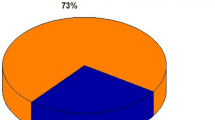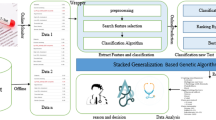Abstract
Classification is an important data mining task in biomedicine. For easy comprehensibility, rules are preferrable to another functions in the analysis of biomedical data. The aim of this work is to use a new fuzzy immune rule-based classification system for a medical diagnosis of a cardiovascular disease. In this study, fuzzy immune approach (FIA), which can be improved by ours, is a new method and firstly, it is applied to ECG dataset. The performance of the proposed approach, in terms of classification accuracy, ROC curves, and area under the ROC curve (AUC) was compared with traditional classifier schemes: C4.5, Naïve Bayes, KStar, Meta END, and ANN. The classification accuracies and AUC statistics of FIA for the data sets used are the highest among the classifiers reported on the UCI website and other classifiers used for related problems and tested by cross validation.
Access this chapter
Tax calculation will be finalised at checkout
Purchases are for personal use only
Preview
Unable to display preview. Download preview PDF.
Similar content being viewed by others
References
Alatas, B., Akin, E.: Mining Fuzzy Classification Rules Using an Artificial Immune System with Boosting. In: Eder, J., et al. (eds.) ADBIS 2005. LNCS, vol. 3631, pp. 283–293. Springer, Heidelberg (2005)
Alves, R.T., et al.: An artificial immune system for fuzzy-rule induction in data mining. In: Yao, X., et al. (eds.) PPSN 2004. LNCS, vol. 3242, pp. 1011–1020. Springer, Heidelberg (2004)
Bamber, D.: The area above the ordinal dominance graph and the area below the receiver operating characteristic graph. Journal of Mathematics and Psychology 12, 387–415 (1975)
Cleary, J.G., Trigg, L.E.: K: An Instance- based Learner Using an Entropic Distance Measure. In: Proceedings of the 12th International Conference on Machine Learning, pp. 108–114 (1995)
Cox, E.: The Fuzzy Systems Handbook: A Practitioner’s Guide to Building, using, and Maintaining Fuzzy Systems. Academic Press, Cambridge (1994)
Dasgupta, D. (ed.): Artificial Immune Systems and Their Applications. Springer, Heidelberg (1999)
Davis, J., Goadrich, M.: The Relationship Between Precision-Recall and ROC Curves. In: 23rd International Conference on Machine Learning (ICML), Pittsburgh, PA, USA, June 26-28 (2006)
Gonzales, F.A., Dasgupta, D.: An Immunogenetic Technique to Detect Anomalies in Network Traffic. In: Proceedings of Genetic and Evolutionary Computation, pp. 1081–1088. Morgan Kaufmann, San Francisco (2002)
Green, D.M., Swets, J.M.: Signal detection theory and psychophysics. John Wiley & Sons Inc., New York (1966)
Grzymala-Busse, J.W., Hu, M.: A Comparison of Several Approaches to Missing Attribute Values in Data Mining. In: Ziarko, W.P., Yao, Y. (eds.) RSCTC 2000. LNCS (LNAI), vol. 2005, pp. 378–385. Springer, Heidelberg (2001)
Güvenir, H.A., Acar, B.: Feature selection using a genetic algorithm for the detection of abnormal ECG recordings. In: Proceedings of the World Conference on Systemics, Cybernetics and Informatics (ISAS/SCI 2001), Orlando, FL, pp. 437–442 (2001)
Kalina, A., Mężyk, E., Unold, O.: Accuracy Boosting Induction of Fuzzy Rules with Artificial Immune Systems. In: Proceedings of the International Multiconference on Computer Science and Information Technology, Wisla, Poland, pp. 155–159 (2008)
Lin, W., Jin, R., Hauptmann, A.: Meta-classification of Multimedia Classifiers. In: International Workshop on Knowledge Discove. In: Multimedia and Complex Data, Taipei, Taiwan (2002)
Marsala, C.: Fuzzy Partitioning Methods, Granular Computing: An Emerging Paradigm, pp. 163–186. Physica-Verlag GmbH, Heidelberg (2001)
Mężyk, E., Unold, O.: Speed Boosting Induction of Fuzzy Rules with Artificial Immune Systems. In: Mastorakis, E.M., et al. (eds.) Proc. of the 12th WSEAS International Conference on Systems, Heraklion, Greece, July 22-24, pp. 704–706 (2008)
Mężyk, E., Unold, O.: Improving Mining Fuzzy Rules with Artificial Immune Systems by Uniform Population. In: Mehnen, J., et al. (eds.) Applications of Soft Computing. AISC, vol. 58, pp. 295–303. Springer, Heidelberg (2009)
Nasaroui, O., Gonzales, F., Dasgupta, D.: The Fuzzy Artificial Immune System: Motivations, Basic Concepts, and Application to Clustering and Web Profiling. In: Proceedings of IEEE International Conference on Fuzzy Systems, pp. 711–716 (2002)
Pedrycz, W.: Granular Computing. Studies in Fuzziness and Soft Computing. Physica-Verlag, Heidelberg (2001)
Piatetsky-Shapiro, G., Frawley, W.J.: Knowledge discovery in databases. AAAI Press, Menlo Park (1991)
Polat, K., Sahan, S., Gn̈es, S.: A new method to medical diagnosis: Artificial immune recognition system (AIRS) with fuzzy weighted preprocessing and application to ECG arrhythmia. Expert Syst. Appl. 31(2), 264–269 (2006)
Polat, K., Akdemir, B., Gune, S.: Computer aided diagnosis of ECG data on the least square support vector machine. Digital Signal Processing 18, 25–32 (2008)
Quinlan, J.R.: C4.5: Programs For Machine Learning. Morgan Kaufmann, San Mateo (1993)
Rish, I.: An empirical study of the naive Bayes classifier. In: IJCAI 2001 Workshop on Empirical Methods in Artificial Intelligence (2001)
Soman, T., Bobbie, P.O.: Classification of arrhythmia using machine learning techniques. In: Proc. of 4th International Conference on System Science and Engineering (ICOSSE), Copacabana, Rio de Janeiro, Brazil (2005)
Witten, I.H., Frank, E.: Data Mining: Practical Machine Learning Tools and Techniques, 2nd edn. Morgan Kaufmann, San Mateo (2005)
Zolghadri Jahromi, M., Taheri, M.: A proposed method for learning rule weights in fuzzy rule-based classification systems. Fuzzy Sets and Systems 159, 449–459 (2008)
Author information
Authors and Affiliations
Editor information
Editors and Affiliations
Rights and permissions
Copyright information
© 2011 Springer-Verlag Berlin Heidelberg
About this paper
Cite this paper
Unold, O. (2011). Diagnosis of Cardiac Arrhythmia Using Fuzzy Immune Approach. In: Dobnikar, A., Lotrič, U., Šter, B. (eds) Adaptive and Natural Computing Algorithms. ICANNGA 2011. Lecture Notes in Computer Science, vol 6594. Springer, Berlin, Heidelberg. https://doi.org/10.1007/978-3-642-20267-4_28
Download citation
DOI: https://doi.org/10.1007/978-3-642-20267-4_28
Publisher Name: Springer, Berlin, Heidelberg
Print ISBN: 978-3-642-20266-7
Online ISBN: 978-3-642-20267-4
eBook Packages: Computer ScienceComputer Science (R0)




